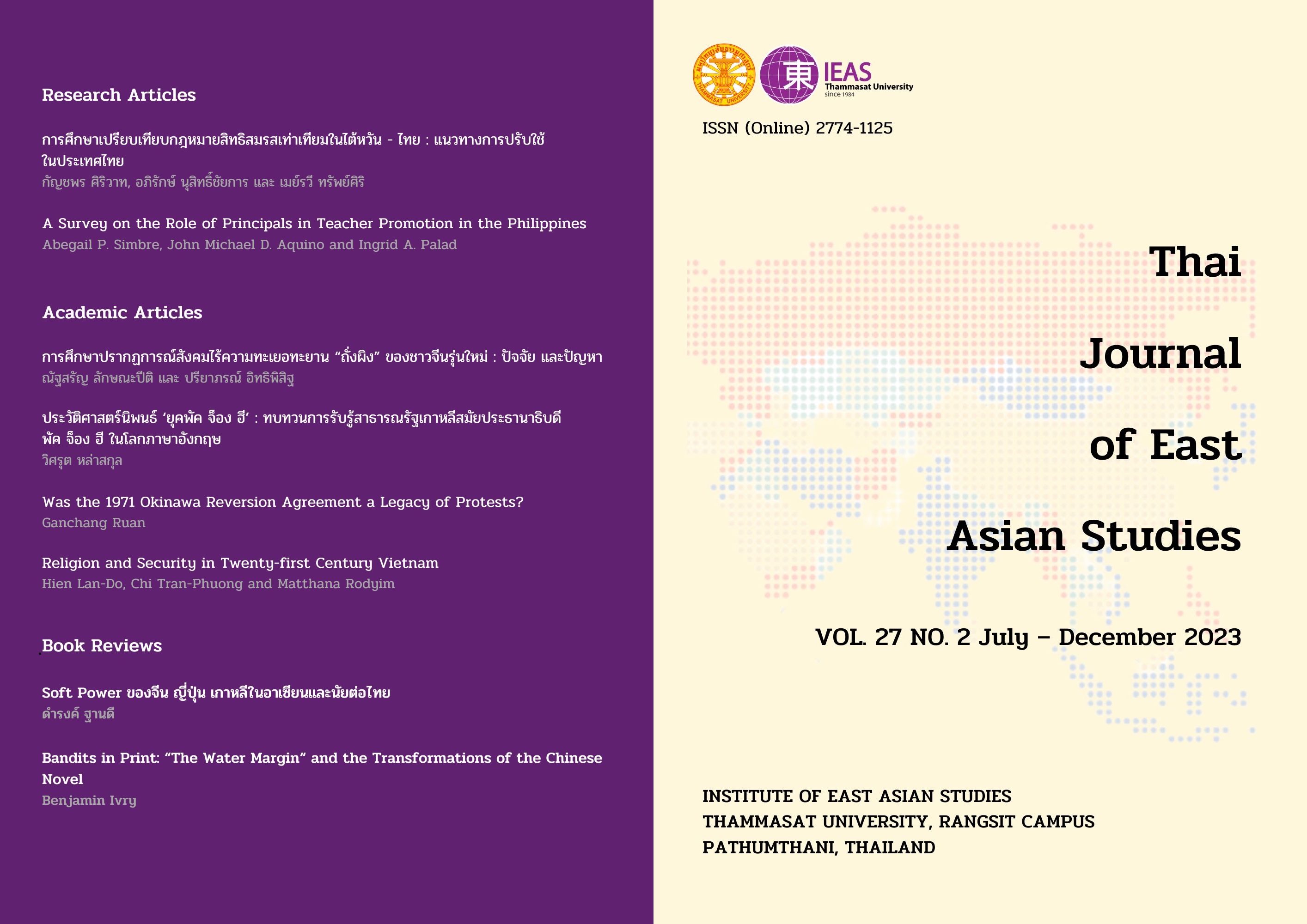การศึกษาปรากฏการณ์สังคมไร้ความทะเยอทะยาน “ถั่งผิง” ของชาวจีนรุ่นใหม่ : ปัจจัย และปัญหา
คำสำคัญ:
ปรากฏการณ์สังคมไร้ความทะเยอทะยาน, ถั่งผิง, ปัจจัยที่มาของปัญหาทางสังคม, ปัญหาสังคมจีนบทคัดย่อ
เศรษฐกิจและสังคมของจีนกำลังพัฒนาอย่างรวดเร็ว และมีแนวโน้มที่จะกลายเป็นประเทศมหาอำนาจอันดับหนึ่งของโลกในอนาคต อย่างไรก็ตาม ตั้งแต่ปี 2019 จนถึงปัจจุบัน จีนต้องเผชิญหน้ากับความท้าทายและปัญหาที่ควบคุมยากอย่างปรากฏการณ์สังคมไร้ความทะเยอทะยาน “ถั่งผิง”
ปรากฏการณ์ “ถั่งผิง” (躺平) ภาษาอังกฤษเรียกว่า Lying Flat คำดังกล่าวสื่อความหมายตรงตัวในภาษาไทยว่า “การนอนราบ” เป็นกระแสในโลกออนไลน์เมื่อตอนกลางปี 2021 ซึ่งเป็นช่วงสถานการณ์การแพร่ระบาดของโรคติดเชื้อไวรัสโคโรนา 2019 ลักษณะเด่นของบุคคลที่ตกอยู่ในสภาวะดังกล่าวคือ ขาดความทะเยอทะยาน เมินเฉยต่อสังคมรอบตัว ไม่ทุ่มเท ขาดความเพียรพยายามในการสร้างครอบครัว ตลอดจนคำนึงถึงแต่สุขภาวะของตน เป็นต้น หากผู้คนส่วนใหญ่ในจีนมีสภาวะแบบข้างต้น จะส่งผลกระทบในวงกว้างต่อสังคมและเศรษฐกิจ
บทความนี้เป็นบทความวิชาการ ผู้เขียนได้รวบรวมข้อมูลผ่านกระบวนการอ่านวิเคราะห์บทความวิชาการ เอกสารงานวิจัย และสื่อสังคมของจีนเป็นหลัก มีวัตถุประสงค์เพื่อบ่งชี้ให้เห็นถึงปัจจัยที่มา และปัญหาของปรากฏการณ์สังคมไร้ความทะเยอทะยาน “ถั่งผิง” ของชาวจีนรุ่นใหม่ ตลอดจนศึกษาแนวทางการจัดการปัญหาของจีนในปัจจุบัน เพื่อเป็นประโยชน์ต่อการจัดการแก้ไขปัญหาดังกล่าวที่อาจเกิดขึ้นในไทย
Downloads
เอกสารอ้างอิง
ตรีนุช อิงคุทานนท์. (2564, 24 สิงหาคม). “ฉันไม่สน ฉันอยากนอน” การต่อต้านพรรคคอมมิวนิสต์จีนด้วยการไม่ทำอะไรเลย. Thairath Online. https://plus.thairath.co.th/topic/speak/100348?fbclid
พิมพ์ชนก พุกสุข. (2564, 29 ตุลาคม). เจาะปรากฏการณ์ ‘Lying Flat’ เมื่อคนรุ่นใหม่ปราศจากความทะยานอยาก กำลังก่อตัวในจีน. The Standard. https://thestandard.co/lying-flat-in-china
Chen, Y., & Cao, T. (2021). “躺平” :兴起、形成机制与社会后果. 福建论坛(人文社会科学版) , 9, 181-192.
Cyanhill capital. (2021). 青山资本2021年中消费报告:Z世代定义与特征. 青山资本投研中心.
EOL Corporation. (2021). 全国研究生招生调查报告. 中国教育在线. https://www.eol.cn/e_ky/zt/report/2021/content02.html
Global Times. (2021, 15 October). 习近平:要防止社会阶层固化,避免“内卷”“躺平”. https://finance.sina.cn/china/gncj/2021-10-15/detail-iktzscyx9890872.d.html
Hou, Z. (2021). “躺平” 亚文化的生成及反思. 人民论坛, 35, 123-125.
Li, W. (2022). 高校“躺平”现象分析及应对策略. 哈尔滨职业技术学院学报, 6, 106-108.
Liang, J., & Ren, Z. (2021). 中国人口预测报告2023版. 育娲人口研究.
Lin, L., & Gao, Y. (2021). “躺平青年” :一个结构性困境的解释. 中国青年研究, 78-84.
Ling, X., & Li, C. (2022). “躺平主义” 的文化构境、叙事症候及应对策略. 新疆师范大学学报(哲学社会科学版), 43, 124-139.
Ma, C., & Wang, Y. (2022). “躺平主义” 的群像特征、时代成因及其应对策略. 思想理论教育, 4, 107-111.
National Bureau of Statistics. (2023, 18 January). 王萍萍:人口总量略有下降城镇化水平继续提高. http://www.stats.gov.cn/sj/sjjd/202302/t20230202_1896742.html
Qin, X., & Dai, Y. (2022). “内卷” “佛系” 到 “躺平” ——从社会心态变迁看青年奋斗精神培育. 中国青年研究, 5-13.
Sun, G., & Liu, H. (2022). “躺平的佛系青年” ——互联网时代解构主义思潮的符号嬉戏. 思想教育研究, 1(331), 104-108.
Tencent. (2023, 17 February). 中国人口预测报告2023版:出生人口将在2056年被美国反超. 育娲人口研究. https://new.qq.com/rain/a/20230217A00YMS00#:~:
Tsingyan Group. (2022, 10 March). “躺平” 真相来了,结果出乎预料吗?. http://www.tsingyangroup.com/?p=7841
Wikipedia. (2022, 24October). 996工作制. https://zh.wikipedia.org/wiki/996%E5%B7%A5%E4%BD%9C%E5%88%B6
Xiang, Y. (2021). 祛魅与重构:“躺平文化”的社会根源及文化反思. 新疆社会科学, 5, 146-152.
Xiao, G., & Lin, C. (2022). 小康社会建设:中国式现代化道路的实践形态. 陕西师范大学学报 (哲学社会科学版), 51(4), 5-15.
Xie, S. (2021). 三和青年”的社会学叙事方法、结构与空间. 青年学报, 01, 50-54.
Xinhuanet. (2023, 01 February). 想去三、四线城市就业大学生占比呈上升趋势. 新华网. https://www.xinhuanet.com/edu/20230201/5e06f410297e4e02bc8063e399bc60f0/c.html
Young. (2021, 31 May). 躺平即是正义. 墨滴. https://mdnice.com/writing/ae0bdc8070cb4dcea901eede3bd93434
Yu, W. (2022). 当代青年“躺平”现象的成因与消解对策分析. 领导力论坛, 11(205), 109-113.
庄园三里说. (2022, 04 March). “卷王”的时代. 知乎. https://zhuanlan.zhihu.com/p/476022182
ดาวน์โหลด
เผยแพร่แล้ว
รูปแบบการอ้างอิง
ฉบับ
ประเภทบทความ
สัญญาอนุญาต
ลิขสิทธิ์ (c) 2023 Thai Journal of East Asian Studies

อนุญาตภายใต้เงื่อนไข Creative Commons Attribution-NonCommercial-NoDerivatives 4.0 International License.



